First, a disclaimer: I don’t profess to be any kind of expert in street art. Or even a novice, really. I just know that, when I spot a fresh stencil or spy some sick piece, it makes me smile—and, if I happen to have a camera with me, snap some photos.
I guess the thing about street art is the sense of place it evokes—which one naturally notices more when one is traveling, seeing a city with fresh eyes. As the world gets smaller, regionalism can be hard to find; this is especially true in the Westernized world. Traveling in Western Europe, you constantly see the same chainstores, the same brands, the same fashions—girls are wearing whatever’s hip at H&M everywhere from Malmo to Madison (and I’d like to say myself excluded, but that would be a lie). Street art, whether it’s good or not, shatters through that; its viscerality marks a place, claims it, and if you’re traveling, can often reveal a lot more about where you are than reconstructed period buildings and restaurants with picture menus (really, paella all kinda looks the same).
I hung around some East Bay graf kids for a time, and still smile when I see their tags around town. A repeated stencil, a tag, a distinctive style—they’re like recurring images from a dream, someone else’s dream, and you catch little glimpses, train your eyes to look down alleys and up at overpasses, and you feel like you’re in on something. It grounds you in a very tangible way, connects you with the phantoms that sneak around at 3am with backpacks full of clanging illegality, with their finger-staining passions and illicit dreams. Of course, I was never one of them; a certain romance remains when it’s not you getting arrested or jumped in some strange turf battle. But I will say you interact with a city—its architecture and landscape, its thingness—differently when you’re even vaguely in tune with its street art. And when you’re traveling, it can often be your only contact with the night-crawling kids that in large part create the pulse of a place.
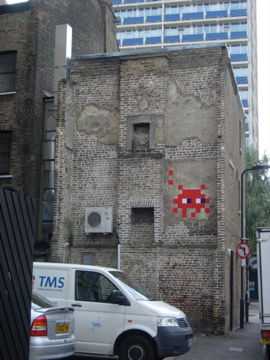
My first stop on my trip was London, where I of course went on an all-day goose chase for Banksy (chronicled here). The hunt also took me past several of these digitized little fellows by Invader..

Super poor picture quality, but what can you expect from a 2am street lamp and a mediocre camera? This I spotted in Madrid, near Plaza Sol. If you can't tell, it's two tangoing figures with security cameras for heads.

Granada generally had some piss-poor graffiti and stencils, but this one made me laugh. Totally fitting for a college town.

I spotted this one several times around the beach breakers in Tarifa. The sentiment jived well with the surf-town vibe, and the fact that it was in English spoke to the internationalism of the unassuming little place-between-places.

As you might guess, there wasn't a whole lot of street art going on in Morocco, or at least in the places I went. What one does see a lot of is stenciled Muslim calendars, on the side of buildings, with icons depicting certain holidays and dates. My favorite was the rose. I of course have no idea what it denoted or what the Arabic says, and retained none of the heavily accented, half-French explanations.
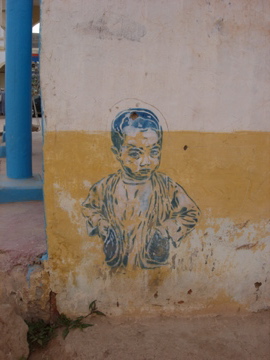
But of course, the best stencil piece I saw was in one of my favorite dirt-road beach towns, Mirleft. Popular with vacationing Marrakeshis, artists, dreadlocked travelers and, well, me, Mirleft seemed a perfect place to find this, peeling away on a side street.

Back in Europe, much of Lisbon's street art had a distinctive Brazilian flavor, which makes sense considering the city's large Afro-Brazilian population, and the fact that São Paulo and Rio are some of the biggest and baddest producers of street art in the world. I saw this stencil around the center, around uber-hip Barrio Alto.
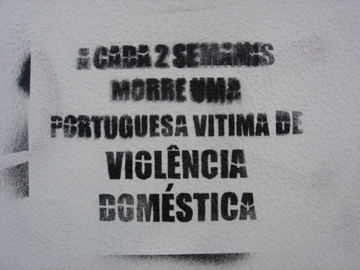
Another college town, Coimbra had a fair amount of politicized stencils. This one was especially interesting given the prevalence of domestic violence in Portugal, and the pervading stigma against seeking help: "Every 2 weeks, a Portuguese victim of domestic violence dies." The number is a little more somber when you consider the small country's population of 10 million.

But the place that really took the cake was Porto. Good ole unsuspecting Porto, forever in the shiny, smiley shadow of Lisbon. These were all taken near hip-slick-and-cool Rue Miguel Bombara.
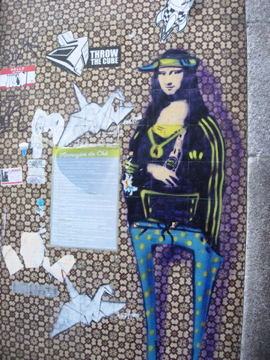
The paper cranes were part of the 1000 Tsuri Project. They acted like punctuation, all over the walls of the street, serving as both a kind of visual break and space filler between the other pieces.

Part of a larger project by artist Costah; check more out here: http://www.costah.net/the-icons.html

This little girl is up a few places; each time, she's touching something different. From what I could tell, this was the logo of a nearby art gallery/collective.
I don’t know if these reveal any more about the places I was in, but to me they do. And if nothing else, they’re better than cell phone ads.
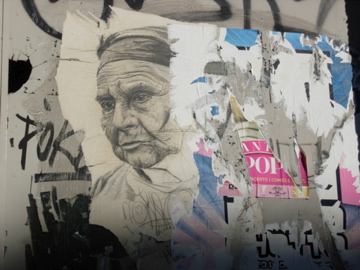

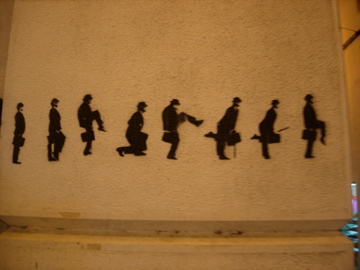



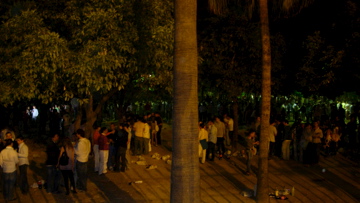 The roar of voices rose from between the trees, out of the darkness and dirt. Scooters swarmed, freshly broken glass glittered in the dim park lights. Young girls teetered in impossibly high heels and boys stumbled, leaned their faces against the sides of walls as they pissed. And every person clutched a plastic cup.
The roar of voices rose from between the trees, out of the darkness and dirt. Scooters swarmed, freshly broken glass glittered in the dim park lights. Young girls teetered in impossibly high heels and boys stumbled, leaned their faces against the sides of walls as they pissed. And every person clutched a plastic cup. Down a
Down a  The streets I wandered got starker, more litter-filled than people-filled. Abandoned buildings and dirt lots suggested that restoration efforts weren´t the trend in this forgotten corner, perched on a precipice between well-visible, touristed neighborhoods. A steep stone footpath lightning-bolted its way down the hillside; I followed it.
The streets I wandered got starker, more litter-filled than people-filled. Abandoned buildings and dirt lots suggested that restoration efforts weren´t the trend in this forgotten corner, perched on a precipice between well-visible, touristed neighborhoods. A steep stone footpath lightning-bolted its way down the hillside; I followed it.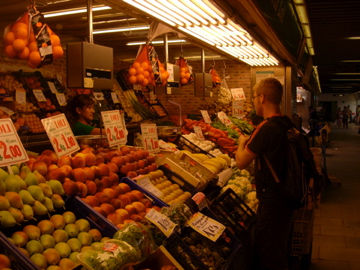


Recent Comments